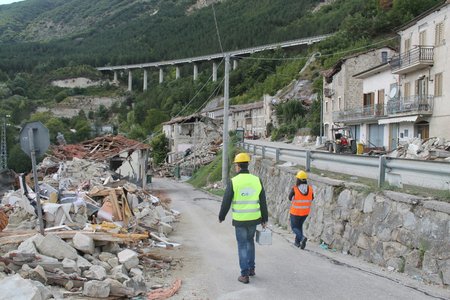Italy has a long history of seismological history concerning also seismic hazard and risk assessment. The importance of local effects emerged in the 1846, when the scientist Leopoldo Pilla in the “Istoria del tremuoto che ha devastato i paesi della costa toscana il 14 agosto 1846” claimed that “La esperienza ha dimostrato in Italia che i paesi sono flagellati dal tremuoto principalmente in ragione della natura e forma del suolo in cui sono situati […] si può ad essi assegnare l'ordine crescente che segue di esposizione al pericolo: paesi situati sopra monti di rocce sode; paesi in pianura; paesi giacenti sopra poggi di rocce friabili (The experience showed in Italy that villages are struck by earthquakes mainly because of the nature and shape of the soil on which they lay […] to them it can be assign the increasing order of exposure to danger: villages sited above mountains made of compact rocks; villages sited on plains; villages lying on hills of loose rocks)”. Despite the observations of Pilla, 50 years were spent before these matters were considered in Italy.
The first Seismic Microzonation (SM) study is represented by the report of Mario Baratta after the great 1908 earthquake that wholly destroyed the Reggio Calabria and Messina cities (Mw=7.2; XI MCS). The report purpose was to understand the phenomenon, by the detailed reconstruction of building damages in relation whit the morphological and geological features of the study area. General indications emerged from this study for reconstruction planning which were later integrated in technical standards for reconstruction spread through the R.D. law n. 193 of 18/04/1909. Besides the introduction of a first national seismic classification, this Decree contains the interdict of building under “terreni posti sopra o presso fratture, franosi o atti comunque a scoscendere, od a comunicare ai fabbricati variazioni e sollecitazioni tumultuarie per differente costituzione geologica o diversa resistenza delle singole parti di essi (lands placed on or near fractures, landslides or landslide-prone areas, or prone to transfer to motions and stress variations to buildings because of the different geological constitution and resistance of their individual parts)”.
From 1908 to1970, the Baratta report remains the only Seismic Microzonation study in Italy, while overseas SM studies were developed since the '50s. In Japan scientists Kanai and Tanaka, from the 1952, published a series of studies aimed at defining correlations between local geological conditions and frequencies from the microseismic background noise. In the 1965, the soviet scientist Medvedev proposed a method of Seismic Microzonation which had a wide application in the following years.
After the San Francisco earthquake (1957) and the following events of Mexico City (1986), Kobe (1992) and Izmit (1999) numerous studies were conducted to put in evidence that the seismic action can be altered from the local geological characteristics.
From 1970 to 1980, In Italy were managed three experimental, low cost and quick, Seismic Microzonation studies, applying the Kanai’s and the Medvedev’s methods, in the Val Rosandra area (1970), Matera (1973) and Palermo (1979). These studies were conducted just after seismic events but did not have any effects on current legislation.
After the Ancona (1972) and Friuli (1976) earthquakes were made two in depth Seismic Microzonation studies (Ancona and Tarcento towns) in the post-event period, with extensive collections of borehole data, and subsequent 1D and 2D modelling that laid the methodological bases for future studies.
Following the destructive Irpinia (1980) earthquake, across Campania and Basilicata, it was promoted the “Progetto Finalizzato Geodinamica” activities in support of the reconstruction of the damaged areas, with coordination of CNR, and collaboration of Universities, Research Institutions and Regions.This Project was the opportunity for applying extensively and testing what previously emerged from the experiences of Ancona and Tarcento: in fact, this is a turning point because 39 are the towns of Campania and Basilicata involved. Due to the great extension of the involved area, there was a large commitment of expeditious (quick) methods, essentially quantitative, whilst particularly important were considered the geomorphological investigations focusing on the mapping of areas prone to instability.
Among the products developed within the "Progetto Finalizzato Geodinamica", it is relevant the "Elementi per una guida alle indagini di Microzonazione Sismica" edited by CNR in the 1986, the purpose of which is to provide to a specialized audience a critic orientation to the Seismic Microzonation investigation, take advantage of the experiences spread in the previous decade on the whole national territory.
Another important experience was conducted after the Umbria-Marche earthquake of 1997. On the base of their local representative stratigraphic and geomorphological characters, 60 places were selected in order to conduct Seismic Microzonation studies that will have had significant effects on reconstruction.
In the 1997 the Toscana Region promoted geological, geotechnical and geophysical investigations in many sites, through the “Programma VEL (Valutazione Effetti Locali)”, to characterize the areas with uniform behavior on the basis of local seismic response, providing useful information for building design and for land planning.
An important turning point is the San Giuliano di Puglia (Mw5.8) event of 2002: from this moment the Seismic Microzonation is regarded as an instrument for prevention of seismic risk and no longer for the only emergency management.
The progressing of the different experiences and the increasing multi- and inter-disciplinary approaches of the methods resulted in 2006 in the Institution of a Task Force, composed by technicians and experts nominated by Regions and by the Civil Protection Department of Italy, to issue on 2008 “Indirizzi e criteri per la Microzonazione Sismica” (Guidelines for Seismic Microzonation, 2015). This publication defines the investigation methods and the criteria for Seismic Microzonation studies, thus representing a national reference for seismic characterization of the territory, also presenting selected case studies.
The methods and recommendations reported in “Indirizzi e criteri per la Microzonazione Sismica” were immediately tested on 2009-2010, in consequence of the L’Aquila earthquake (6 april 2009); just on May 2009 it was started a Seismic Microzonation plan in areas with macroseismic intensity equal to or greater to VII level MCS (Microzonazione sismica per la ricostruzione dell’area aquilana, 2010).
An analogoue procedure was acted after the earthquake of Emilia Romagna (May 2012), when it was considered necessary proceeding to Seismic Microzonation studies in residential area of those municipalities in which effects of macroseismic intensity equal to or greater to VIlevel MCS were observed.
New national laws (among which the Law n.77/2009) were emanated after the L’Aquila earthquake, entrusted to Civil Protection Department, is controlled by different ordinances which identify in Seismic Microzonation a key tool for seismic risk prevention at municipal scale.



